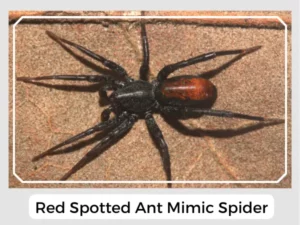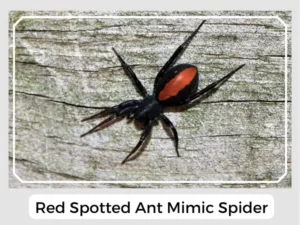The red-spotted ant mimic spider is super clever! It walks on six legs and uses its front legs like ant antennas. This tricks the ants into thinking it’s one of them. Then, the spider can be near the ants and even hunt them. Want to know more? We have some cool facts to share!

Photo Credit: David E. Hill

Photo Credit: W Bishop
Female spiders produce silk sacs for their eggs, and after wrapping all of them inside, the sac is either attached to nearby stones or rocks.
They overwinter and generally hatch in spring and are on their own since the beginning.
No specific information is found as far as the web for hunting is concerned, but they make silken sacs near ant colonies where they rest.
Yes, Red-spotted Ant Mimic Spiders have venom. They use it mainly to catch their ant meals. They have venom that is only effective on small prey and not on humans.
They can bite, but they’re usually busy acting like ants. If they feel cornered or super scared, they might defend themselves with a bite. But most times, they’re just sneaky spider actors!
The red-spotted ant mimic spider’s behavior is crucial for its survival. By mimicking ants, not only does it blend in with its prey, but it also avoids being preyed upon by other predators. This spider plays a significant role in controlling ant populations, thus influencing the ecological dynamics of their habitat.
Natural Predators: Although mimicking ants provides a level of camouflage, these spiders still face threats from birds and larger predatory insects that can distinguish them from their ant models.
Prey-Predator Dynamics: The red-spotted ant mimic spider’s venom is specifically adapted to subdue ants and small insects, showcasing a fascinating predator-prey relationship that aids in maintaining the balance of insect populations within their ecosystem.
Relationship with Humans: Humans rarely interact directly with these spiders as they are non-aggressive and tend to avoid human activity. They are not a danger to people, and while they can bite, such instances are exceedingly rare and the venom is not harmful to humans.
| Distribution | Canada and the United States |
| Habitat | Shrubs, woods, parks, and stones |
| Diet | Ants and small insects |
| IUCN Conservation Status | Not Listed |
In summary, the red-spotted ant mimic spider is a fascinating example of mimicry in nature, serving an essential role in the control of ant populations and demonstrating the diverse survival strategies that have evolved in the arachnid world.
The red-spotted ant mimic spider is super clever! It walks on six legs and uses its front legs like ant antennas. This tricks the ants into thinking it’s one of them. Then, the spider can be near the ants and even hunt them. Want to know more? We have some cool facts to share!

Photo Credit: David E. Hill

Photo Credit: W Bishop
Female spiders produce silk sacs for their eggs, and after wrapping all of them inside, the sac is either attached to nearby stones or rocks.
They overwinter and generally hatch in spring and are on their own since the beginning.
No specific information is found as far as the web for hunting is concerned, but they make silken sacs near ant colonies where they rest.
Yes, Red-spotted Ant Mimic Spiders have venom. They use it mainly to catch their ant meals. They have venom that is only effective on small prey and not on humans.
They can bite, but they’re usually busy acting like ants. If they feel cornered or super scared, they might defend themselves with a bite. But most times, they’re just sneaky spider actors!
The red-spotted ant mimic spider’s behavior is crucial for its survival. By mimicking ants, not only does it blend in with its prey, but it also avoids being preyed upon by other predators. This spider plays a significant role in controlling ant populations, thus influencing the ecological dynamics of their habitat.
Natural Predators: Although mimicking ants provides a level of camouflage, these spiders still face threats from birds and larger predatory insects that can distinguish them from their ant models.
Prey-Predator Dynamics: The red-spotted ant mimic spider’s venom is specifically adapted to subdue ants and small insects, showcasing a fascinating predator-prey relationship that aids in maintaining the balance of insect populations within their ecosystem.
Relationship with Humans: Humans rarely interact directly with these spiders as they are non-aggressive and tend to avoid human activity. They are not a danger to people, and while they can bite, such instances are exceedingly rare and the venom is not harmful to humans.
| Distribution | Canada and the United States |
| Habitat | Shrubs, woods, parks, and stones |
| Diet | Ants and small insects |
| IUCN Conservation Status | Not Listed |
In summary, the red-spotted ant mimic spider is a fascinating example of mimicry in nature, serving an essential role in the control of ant populations and demonstrating the diverse survival strategies that have evolved in the arachnid world.